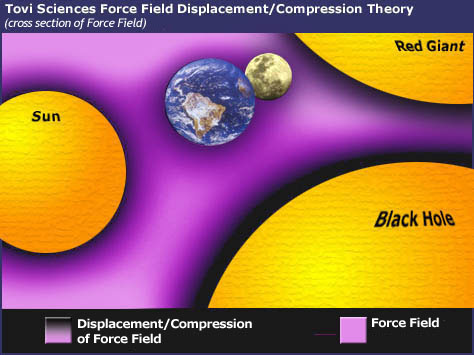A New Matrix for the Cosmos
by Murray Tovi.
For over three centuries science has been blind to an invisible medium occupying space, a vast field of force holding far more energy than a black hole and moving at a very high velocity on the order of hundreds, if not thousands of kilometers per second.
It was first detected everywhere in the sky by Arno Penzias and Robert Wilson in 1964 but erroneously mislabeled as background radiation from the Big Bang. Unknown in 1887 it caused the mysterious Michelson-Morley failure called null effect that closed the door on classical science and opened the door for Albert Einstein. That error, it will be shown, would lead to almost a century of distortion regarding the structure of the cosmos.
Its presence eluded Galilee Galileo and Isaac Newton who both searched diligently but unsuccessfully forcing them to publish their exquisitely chronicled effects sans cause, as trees without roots, a poor foundation for what was to be called the foundation of classical science.
It has been called by many names. Einstein searched for gravity waves until his death. Michelson and Morley searched for the aether drift to no avail. Astrophysicists, theoretical astrophysicists and astronomers searching to no avail for generations for super-colossal concentrations of dark matter and more recently for vast fields of dark energy.
Unfortunately, they were or are looking in the wrong place and with the wrong perspective as we are inside of this rapidly moving medium looking out, unable to see the forest for the trees.
Based on the Big Bang theory, this forest, the hypothesized mother of all forces, causes gravity by its displacement following the simple laws of liquid dynamics.
It is why red and blue giants are precursors to black holes, even larger in mass where light blinks out entirely from colossal displacement.

To continue, it causes inertia by its restraining presence everywhere. Something does not come from nothing.
It negates the need for a yet to be found anti-gravity ring (the cosmological constant) around stars to protect them from their mutual gravitational attraction as it is the glue that holds stars and a galaxy in place.
It is why telemetry reaches a deep space probe with nanosecond accuracy to begin a critical course maneuver and why a laser can hit a target a hundred miles away with utmost precision. Both accomplished without knowledge of the true speed and direction of the target, knowing only the relative data.
Finally it is why light and the entire electromagnetic spectrum is constantly modified in velocity and/or trajectory as it passes through this medium creating the illusion that 299,792.458 kilometers per second is a real number when it is only relative number, the truth unseen by our mutually enveloped moving perspective.Thus, under this hypothesis, the observed movement of light is not paradoxical, but completely natural and relative to the speed and direction of the observer. As such it is relative to the speed of time, perhaps razing to the ground the jailhouse Einstein built for mankind.
After all the stars beckon us to come, as perhaps they have already done to others.
Enough said. Here is the proof.
Detection of the medium is based on any of the following estimates being true:
- The Sun is moving at 217 kilometers per second in its orbit around the Milky Way center. (See research below).
- The Milky Way, as part of a local group of galaxies, is moving at between 300 and 600 kilometers per second in the direction of the constellation Hydra. (See research below).
- The Milky Way is moving at 30,500 kilometers per second or half the receding velocity of Ursula 2, the farthest and fastest receding galaxy, a logical assumption (one of many) based on the behavior of an unconfined explosion as may have occurred at the Big Bang.
The Events
The following three events provide clear evidence of a fundamental force that has escaped detection since the beginning of modern science in the 17th century.
The first event is hypothetical. The second was seen by over a billion witnesses world-wide. The third was conducted in 2000 and again in modified form in 2001. It has never been reported by any media outlet.
- The Moon Laser Experiment
- The Twin Towers Study
- The Laser Drag Experiments
Supporting Evidence.
The following list includes relevant watershed experiments, treatises, observations, etc. that support the existence of this conditionally discovered medium. For a full description, Google each topic on this list and type in the subject experiment, etc.
- Newton ‘s Law of Gravitation.
- Newton ‘s failure to find its origin.
- Newton ‘s Three Laws of Motion.
- Newton ‘s failure to find the origin(s) of inertia, momentum and recoil.
- Galileo’s treatise on falling bodies.
- Galileo’s failure to discover the origin of the peculiar phenomena.
- Newton ‘s failed formula E=mv.
- deGravesend’s discovery of the multiplier effect (E=mv2 ).
- The failure by physicists (then called chemists) to logically explain the phenomenon.
- The discovery of centrifugal force.
- The inability to discover its origin.
- Fizeau’s Water Drag experiment inspiring Michelson and Morley.
- Fizeau’s discovery of red-shift from light emanating from receding objects.
- Michelson and Morley’s aether drift experiment predicting an invisible moving force in space.
- The failure by chemists to explain logically the experiment’s puzzling null effect.
- Rubin’s discovery of black holes.
- Einstein’s prediction of light deflection by intense gravity.
- The 1919 and 1922 solar eclipse observations of gravity’s effect on star light confirming Einstein’s prediction.
- Einstein’s Cosmological Constant theory keeping stars from colliding from their mutual gravitational attraction.
- The failure to date to locate such anti-gravity rings around the Sun or any other stars.
- The inability to reproduce anti-gravity in the laboratory.
- Einstein’s Singularity theory on the super condensed physical structure of a black hole.
- The inability to demonstrate such super condensed matter in a laboratory.
- The prediction that the Universe is made up mostly of dark matter.
- The failure, after decades of searching, to discover significant amounts of such matter.
- The discovery of Red and Blue giants (stars).
- The prediction of vast fields of colossal dark energy occupying space.
- The failure to date to locate such fields.
- Einstein’s prediction of gravity waves.
- His failure to find any in his lifetime.
- Alvager’s neutral pion accelerator experiment confirming that light does not take on the velocity or trajectory characteristics of it source.
- Hubble’s discovery of star clusters (galaxies)
- Humason’s red-shift analysis indicating galaxies moving at super-colossal velocities.
- The red-shifting to date of over 500,000 galaxies confirming all galaxies measured to date receding at super-colossal velocities.
- Penzias and Wilson ‘s discovery of microwave radiation everywhere in the sky.
- Synchronized atomic clock measurements here and in orbit proving time is elastic.
- Accelerator experiments with nuMesons suggesting substantial time slowing at the speed of light barrier.
- Accelerator experiments with protons proving matter cannot exceed the speed of light.
- The liquid dynamics laws of displacement.
- The spiral construction of galaxies.
- The elliptical orbits of planets in the solar system.
- The artificial gravity in the space station.
- The apparent lens effect (elongation) from light arriving from many galaxies.
- The ability of telemetry to reach a target with nanosecond precision.
- The ability of a laser to hit with exacting precision an optically aligned target.
- The velocity measurement of light from any vantage point.
- The trajectory observation of a laser beam from any vantage point.
- Einstein’s Zero Volume theory.
- The inability to create matter from nothing in a laboratory or anywhere else.
- The Hubble telescope discovery of “invisible” halos surrounding at least 48 galaxies.
This concludes A New Matrix for the Cosmos
Tovi Sciences
A fatal flaw in the laws of physics
(A scientific study redefining the structure of the Universe)
Copyright © 2004-2023 by Murray Tovi
Speed of the Sun
The Physics Factbook™
|
Bibliographic Entry |
Result (w/surrounding text) |
Standardized Result |
|
Chaisson, Eric, & McMillan, Steve. Astronomy Today.New Jersey: Prentice-Hall, 1993: 533. |
“Measurements of gas velocities in the solar neighborhood show that the sun, and everything in its vicinity, orbits the galactic center at a speed of about 220 km/s ….” |
220 km/s |
|
“Milky Way Galaxy. ” The New Encyclopedia Britannica.15th ed. Chicago: Encyclopaedia Britannica, 1998: 131. |
“The Sun, which is located relatively far from the nucleus, moves at an estimated speed of about 225 km per second (140 miles per second) in a nearly circular orbit.” |
225 km/s |
|
Goldsmith, Donald. The Astronomers.New York: St. Martin’s Press, 1991: 39. |
“If the solar system … were not moving in orbit around the center, we would fall straight in toward it, arriving a hundred million years from now. But because we do move (at about 150 miles per second) along a nearly circular path ….” |
240 km/s |
|
Norton, Arthur P. Norton’s Star Atlas.New York: Longman Scientific & Technical, 1978: 92. |
“… the sun’s neighborhood, including the Sun itself, are moving around the centre of our Galaxy in approximately circular orbits with velocities of the order of 250 km/s.” |
250 km/s |
|
Recer, Paul (Associated Press). Radio Astronomers Measure Sun’s Orbit Around Milky Way. Houston Chronicle. 1 June 1990. |
“Using a radio telescope system that measures celestial distances 500 times more accurately than the Hubble Space Telescope, astronomers plotted the motion of the Milky Way and found that the sun and its family of planets were orbiting the galaxy at about 135 miles per second.” “The sun circles the Milky Way at a speed of about 486,000 miles per hour.” |
217 km/s |
Speed of the Milky Way in Space
The Physics Factbook™
|
Bibliographic Entry |
Result (w/surrounding text) |
Standardized Result |
|
Hall, Stephen S. Mapping the Next Millennium. New York: Random House: 1992, 328, 334. |
“The Great Attractor is … incredibly dense and unimaginably large, lying off at a distance of 150 million light years, in the direction of the Hydra Centaurus supercluster …. Our galaxy, the Milky Way, is caught in the tug of this Great Attractor, and so are we, hurtling — though we’d never know it — toward this mysterious mass at a speed of 370 miles per second.” |
600 km/s |
|
|
“That exact fate befell Vera Rubin and W. Kent Ford, Jr., of the Carnegie Institution of Washington and two colleagues in the mid-1970s. Using complicated and (to hear some astronomers tell it) not entirely convincing measurements, they reported that the Milky Way, our galaxy, had a peculiar velocity of about 500 kilometers per second. In other words, the Milky Way was hurtling about 370 miles per second off the plumb of the big bang. Rubin in fact had suggested the same thing way back in 1950, but her data had been even sketchier, the reaction even chillier.” |
600 km/s |
|
Rhett Herman, How Fast is the Earth Moving? Scientific American: Ask the Experts. 26 October 1998 |
“The galaxies in our neighborhood are also rushing at a speed of nearly 1,000 kilometers per second towards a structure called the Great Attractor, a region of space roughly 150 million light-years (one light year is about six trillion miles) away from us. This Great Attractor, having a mass 100 quadrillion times greater than our sun and span of 500 million light-years, is made of both the visible matter that we can see along with the so-called dark matter that we cannot see.” |
1,000 km/s |
Futurist. Scientist. Artist.
The designs and inventions of Murray Tovi have been featured in publications such as Vogue, Glamour, House & Garden, Architectural Digest, House Beautiful, Popular Science, Popular Mechanics, and The New York Times.

